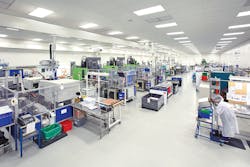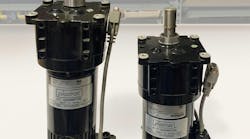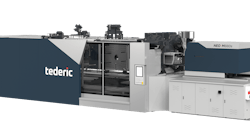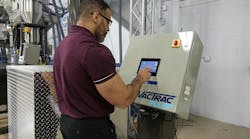To give employees insight into the importance of quality control, management at Evco’s MED (Medical & Electronic Devices) division plant in DeForest, Wis., welcomes medical OEM customers into the facility to show workers how the products they mold save lives.
“One part we mold is used for marking tissue during surgery for patients with breast cancer,” said Gary Fortier, director of U.S. molding operations. “The customer brought in a raw chicken and cut into it to demonstrate how the product is used in surgery. It was a pretty dramatic presentation.”
Making plastic parts that save lives “makes it easy to come to work every day,” said plant manager Bruce Fallahi. “Everyone sees what they do is important. It impacts lives, and, if they don’t do it right, there can be big consequences.”
Evco, which has been making medical parts since 1978, last March completed a $7 million expansion of its DeForest plant dedicated to medical molding.
The expansion took the plant, built in 1996, from 15 injection molding presses to 23, with space created for another 20 in the 23,000-square-foot, Class 8 clean room.
The total expansion, including warehouse and other non-clean-room areas, was 50,000 square feet.
Fallahi and Fortier said plant management is focused on creating work cells that require minimal amounts of human intervention. Automation is key.
“We have to automate as much as we can because of the labor shortage,” Fallahi said. “We try to run as much as we can as a ‘lights-dimmed’ facility. We use a lot of box conveyors, so an operator does not have to be at the press all the time. To do that, you have to do your homework up front.”
Evco has a corporate automation group that is responsible for designing and engineering work cells. Then there is a group at each plant that keeps production cells running. The medical molding plant has three members on its automation team. “Good automation people are hard to find today,” Fortier said.
All the presses in the medical molding facility have clamping forces ranging from 30 tons to 200 tons, but the expansion is designed to accommodate presses with up to 400 tons of clamping force. The eight presses added last year have clamping forces ranging from 55 tons to 130 tons. Two more machines are due this month.
Thirteen of the 23 presses have less than 99 tons of clamping force; seven are between 100 tons and 199 tons; three are 200 tons.
Overall, Evco performs injection molding at five plants in the U.S., three in Mexico and one in China. It molds a wide range of products for markets other than the medical industry.
Three of the U.S. plants are in DeForest; the DeForest medical plant is the company’s largest medical molding facility. The company operates 186 molding machines worldwide.
Evco’s medical molding business grew nearly 20 percent in 2018 over 2017 and is expected to grow about that much again this year. Fortier said keeping pace with the growth is now a major priority.
The DeForest medical molding plant has standardized with injection presses from Engel plus a few from Sodick for tiny parts. Some older machines from other OEMs are being phased out. The oldest injection molding machine in the plant is a 38-ton Arburg purchased in 2004.
The tie-barless Engel machines play a big part in Evco’s production strategy.
“The medical molds for small parts are getting more complex and bigger because they have so many different hydraulics and other features,” Fallahi said. “Tie bars get in the way. We have had really good experiences with Engel machines.”
The Evco MED plant typically runs molds with 16 cavities or fewer.
“You qualify a mold to a press,” Fortier said. “Our customers don’t even want us moving a machine that their product is qualified on.”
That means the company continually has to evaluate the viability of every machine in terms of risk — especially whether parts are still available and the lead times to get them.
Evco does not necessarily keep a molding machine for as long as it can continue to operate. Whenever possible, it replaces a press when it still has value on the used machinery market.
“For many applications, we don’t need tonnage, but we need the daylight to accommodate the larger, complex molds,” Fortier said. “If we had purchased machines with tie bars, we would have had to buy larger machines and would be paying for tonnage we do not need.
“Tie-barless machines give us the best combination,” Fortier said.
An in-house committee analyzed presses from several manufacturers before settling on Engel. The group considered the projects coming in and how to best position the plant for growth.
“Price was an issue, but we found from a cost standpoint that it was comparable because we could buy a smaller Engel machine to achieve the same results of a larger, more traditional machine,” Fortier said. “A mold that we could run on a 55-ton Engel might take a 110-ton press from another manufacturer. Engel is more expensive, but buying a smaller machine evens it out.”
Another important feature was Engel’s quick-barrel-change capability. “That is important when you run a lot of engineering-grade resins,” Fallahi said. “The barrel and shot size have to be just right so you are not degrading the material. That makes the quick-change technology a huge selling point for us.”
The plant uses Sodick presses for tiny, precision parts.
“The shot-to-shot consistency has been impressive on those machines,” Fallahi said.
The plant runs 24/5 and employs 90 people. Worldwide, Evco employs more than 1,300.
On the plant floor, Evco integrates as much assembly and packaging as possible into each highly automated machine cell. Pad printing is also performed in the clean room but not as part of a specific molding cell.
A quality-control lab inside the clean room is equipped with a Hexagon coordinate-measuring machine and a Micro-Vu measuring unit. The lab can perform moisture-content analysis and check parts in a black-light booth.
Material comes into the plant in gaylords, bags and barrels. “We run a lot of different resins,” Fallahi said. The plantwide materials-handling system was built by AEC.
Resin, water and air enter the clean room through underground tunnels. The company installed tunnels during the expansion to accommodate the 20 presses that can eventually be added.
Matsui dryers are used for drying material. The central chilling system is a water-cooled unit from Multistack. Shredders are from Rapid Granulator.
The company uses Branson equipment for ultrasonic welding and Forward Technology equipment for spin welding.
Newer robots are from Epson, Denso and Wemo Automation Group. Older robots are from Hahn Automation.
A robot from Universal Robots picks up parts and puts them into boxes. Conveyors are from EMI Conveyors.
The plant has some products on very long runs and some on short runs. “It is a good mix,” Fallahi said.
One unusual aspect of walking the plant floor is hearing frequent announcements generated by the PlantStar process monitoring system whenever a machine needs attention. “It helps communications between the machine operators and set-up people,” Fallahi said.
The PlantStar production data also is displayed on screens in the molding area.
The company uses an ERP system from QAD.
Despite the access to production data, Fallahi requires supervisors who are beginning or ending their shifts to walk the floor together and look at every machine at every shift change. “Communications at the shift change is so important,” he said. “We make sure we take time to communicate. That transfer of knowledge is critical.”
To train shop-floor team members, Evco uses Paulson Training Programs, the American Injection Molding Institute and RJG Inc.
In planning for new projects, the company plots out the entire process. Fortier said the company looks at every new project as a potential lights-out operation. “We think about what we have to do from a design standpoint upfront so we can run lights-out,” Fortier said. “We need to incorporate that at the beginning.”
Ron Shinn, editor
Contact:
Evco Plastics DeForest, Wis., 800-507-6000, www.evcoplastics.com







